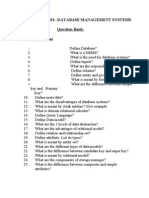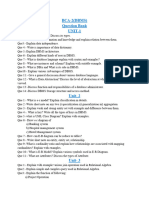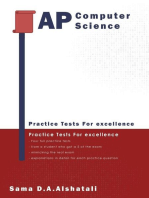Unit-1 & Unit-2 Dbms Questions
Uploaded by
amkrkr95Unit-1 & Unit-2 Dbms Questions
Uploaded by
amkrkr95MOST IMPORTANT QUESTION FROM UNIT-1 & UNIT-2
1. Attempt all questions in brief (short Answer required) 2 x 20 = 40
(a) List any four disadvantages of file system approach over database approach.
(b) Differentiate between physical and logical data independence.
(c) What is the difference between DROP and DELETE command?
(d) What are different Integrity Constraints? (Define constraint and its types in DBMS.)
(e) List the four functions of DBA.
(f) Define aggregation with example.
(g) Name any five database systems?
(h) Write the difference between DDL and DML.
(i) Explain different Features of SQL.
(j) Distinguish between DBMS and RDBMS?
(k) What is data model? List the types of data model used?
(L) Write the difference between super key and candidate key.
(M) Explain the difference between a weak and a strong entity set with example.
(N) Discuss three level of abstractions or schemas architecture of DBMS.
(O) Explain the View in DBMS and its type.
(p) What is Relational Calculus?
(q) What are different relational algebra operations?
(R) Distinguish between Generalization and Serializations?
(s) What is meant by instance and Schema of the database?
(T) Explain the View in DBMS and its type.
(u)Write the difference between Primary Key and Foreign key.
2. Attempt any three of the following: 10x3 = 30
(1)A database is being constructed to keep track of the teams and games of a sport league. A team
has a number of players, not all of whom participate in each
game. It is desired to keep track of players participating in each game for each
team, the positions they play in that game and the result of the game.
(i) Design an E-R schema diagram for this application.
(ii) Map the E-R diagram into relational model
(2) Consider the following schema for institute library:
Student (RollNo, Name, Father_ Name, Branch)
Book (ISBN, Title, Author, Publisher)
Issue (RollNo, ISBN, Date-of –Issue)
Write the following queries in SQL and relational algebra:
(i) List roll number and name of all students of the branch ‘CSE’.
(ii) Find the name of student who has issued a book published by ‘ABC’publisher.
(iii) List title of all books and their authors issued to a student ‘RAM’.
(iv) List title of all books issued on or before December 1, 2020.
(v) List all books published by publisher ‘ABC’
(3)Create an E-R diagram for university registrar office. The office maintains data about each
class, each instructor teaching the class, number of students Enrolled, number of students for
each class, and the time and date of class held. For each student-subject pair, a grade is also
recoded. Take suitable Assumptions if required.
(4) What are the symbols used in E-R diagram? Construct an E-R diagram for a car insurance company
whose customers own one or more cars each. Each car has
associated with it zero to any number of recorded accidents? Also convert the E-R diagram into tables?
(5) Consider the following Scheme:
SUPPLIER (SUPPLIER ID, SUPPLIER_NAME, SUPPLIER_ADDRESS)
PARTS (PART ID, PART_NAME, COLOR)
CATALOG (SUPPLIER ID, PART ID, COST)
Write the following queries in Relational Algebra and in SQL:
(i) Find the name of the suppliers who supply Black Parts.
(ii) Find the name of suppliers who supply both Blue and Black Parts.
(iii) Find the name of suppliers who supply all Parts.
(6) What are Joins? Discuss all types of Joins with the help of suitable examples.
(7) Describe the three-schema architecture. Why do we need mappings between
schema levels? How do different schema definition languages support this
architecture?
(8) What are the different types of Data Models in DBMS? Explain them.
(9) Explain different types of Triggers in SQL/PL SQL.
(10) What do you mean by trigger? Explain it by a suitable example.
(11) Which relational algebra operations require the participating tables to be unioncompatible? Give the Reason in detail.
(12)Differentiate the file system and database Management system by 10 key
factors.
(13) What is the difference between shared data and integrated data? Where are they used in database?
(14) What are the different types of domains used in relational model? Discuss the referential integrity constraint with suitable
example.
(15) What do you mean by view? Explain it with an example. How are they
implemented in DBMS?
(16) What is the relational algebra? Discuss how it differs from relational calculus?
(17) What is ER Diagram? Explain different Components of an ER Diagram with thier Notation. Also make an ER Diagram for
Employee Project Management System.
(18) What is Relational Algebra? Explain Different Operations of Relational Algebra with Example.
(19) What is Data Abstraction? How the Data Abstraction is achieved in DBMS?
(20) Explain the following with example
(i) Generalization
(ii) Specialization
(iii) Aggregation
(21) What is Aggregate Function in SQL? Write SQL query for different Aggregate Function.
(22) Explain Procedure in SQL/PL SQL.
(23) Distinguish the terms: super key, candidate key, primary key, Unique Key and foreign key with example?
(24) Explain the concepts of natural join? Also discuss the types of Outer join with suitable example?
(25) Compare Generalization, Specialization and aggregation with suitable examples.
(26) Write difference between Cross Join, Natural Join, left outer join and right outer join with suitable example.
(27) Discuss the concept of Trigger with a suitable example? Also differentiate between Views and Indexes?
You might also like
- Question Bank of DBMS by Engineering ExpressNo ratings yetQuestion Bank of DBMS by Engineering Express6 pages
- Module Wise Question Bank: Bangalore Institute of Technology K R Road, V V Puram, Bangalore-04No ratings yetModule Wise Question Bank: Bangalore Institute of Technology K R Road, V V Puram, Bangalore-045 pages
- Modulewise Question Bank: Entity-Relationship ModelNo ratings yetModulewise Question Bank: Entity-Relationship Model5 pages
- Database Management Systems (18Cs53) : Course OutcomeNo ratings yetDatabase Management Systems (18Cs53) : Course Outcome20 pages
- DBMS ASSINGment 217b6419 c8c4 45b2 Aff0 d81a9e297d7dNo ratings yetDBMS ASSINGment 217b6419 c8c4 45b2 Aff0 d81a9e297d7d6 pages
- Database Management System: Important Questions Unit-1No ratings yetDatabase Management System: Important Questions Unit-19 pages
- Special DBMS CIA-1 SOLUTION by Prince Verma 209910030073No ratings yetSpecial DBMS CIA-1 SOLUTION by Prince Verma 2099100300733 pages
- Central University of South Bihar: End-Semester Examination 19-July-2021No ratings yetCentral University of South Bihar: End-Semester Examination 19-July-20212 pages
- AP Computer Science Principles: Student-Crafted Practice Tests For ExcellenceFrom EverandAP Computer Science Principles: Student-Crafted Practice Tests For ExcellenceNo ratings yet
- Java / J2EE Interview Questions You'll Most Likely Be AskedFrom EverandJava / J2EE Interview Questions You'll Most Likely Be AskedNo ratings yet
- Shake Table Testin of A Multi-Tower Connected Hybrid Structure - Zhou Ying, Lu Xilin, Lu Wensheng, He Zhijun - Marzo 2009No ratings yetShake Table Testin of A Multi-Tower Connected Hybrid Structure - Zhou Ying, Lu Xilin, Lu Wensheng, He Zhijun - Marzo 200913 pages
- Methodology For Stressing of PSC Girders (C)No ratings yetMethodology For Stressing of PSC Girders (C)2 pages
- Computer Organization: Digital Computer: It Is A Fast Electronic Calculating Machine That Accepts Digitized InputNo ratings yetComputer Organization: Digital Computer: It Is A Fast Electronic Calculating Machine That Accepts Digitized Input52 pages
- Quantum Field Theory A Diagrammatic Approach 1st Edition Ronald Kleiss pdf download100% (1)Quantum Field Theory A Diagrammatic Approach 1st Edition Ronald Kleiss pdf download34 pages
- Introduction To Java Programming Comprehensive Version 9th Edition Liang Test Bank100% (33)Introduction To Java Programming Comprehensive Version 9th Edition Liang Test Bank7 pages
- Evaluation of Ergosterol Composition and Esterification Rate in Fungi Isolated From Mangrove Soil, Long-Term Storage of Broken Spores, and Two SoilsNo ratings yetEvaluation of Ergosterol Composition and Esterification Rate in Fungi Isolated From Mangrove Soil, Long-Term Storage of Broken Spores, and Two Soils15 pages
- Cahigam Es Grade 5 Q1 Data-Bank-In-Math-5No ratings yetCahigam Es Grade 5 Q1 Data-Bank-In-Math-54 pages
- Deep Learning in C# - Understanding Neural Network Architecture - CodeProjectNo ratings yetDeep Learning in C# - Understanding Neural Network Architecture - CodeProject4 pages
- Aerodynamic Analysis of The Undertray of Formula 1 Alberto Gomez PDFNo ratings yetAerodynamic Analysis of The Undertray of Formula 1 Alberto Gomez PDF92 pages
- Uniform Fiber Bragg Grating Modeling and Simulation Used Matrix Transfer MethodNo ratings yetUniform Fiber Bragg Grating Modeling and Simulation Used Matrix Transfer Method7 pages
- Project Report On "Industrial Automation": Submitted in Partial Fulfillment of The Requirement For The Degree ofNo ratings yetProject Report On "Industrial Automation": Submitted in Partial Fulfillment of The Requirement For The Degree of23 pages
- Tekla Structural Designer 2022 Eurocodes ReferenceNo ratings yetTekla Structural Designer 2022 Eurocodes Reference226 pages
- Solcon USA HRVS DN MV 10 13pt8kV Spec Guide 2011100% (1)Solcon USA HRVS DN MV 10 13pt8kV Spec Guide 201110 pages

























































































